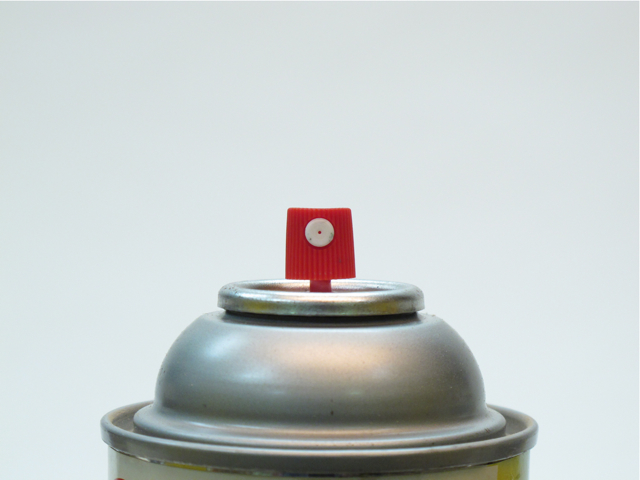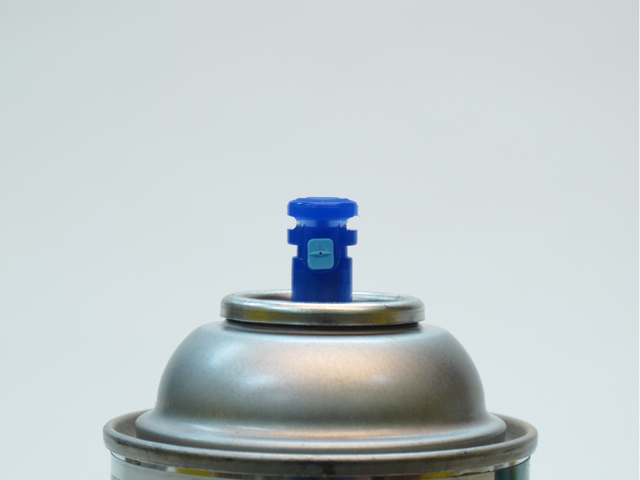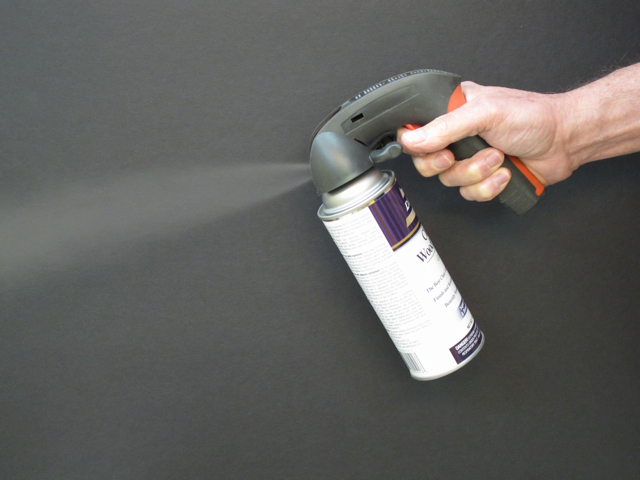We may receive a commission when you use our affiliate links. However, this does not impact our recommendations.

This is what a cone-pattern actuator on an aerosol looks like.
A finishing topic that gets far too little coverage is aerosol finishing. Aerosols are widely available in four common finishes: lacquer, oil-based polyurethane, water-based finish and shellac. The first three are usually available in several sheens, most commonly gloss and satin. Shellac is available only in gloss.
Other than the types, the important thing to know is that there are two types of nozzles: cone and fan pattern. The cone pattern is by far the most common. It produces a cone shape and is identifiable by the simple cylindrical-shaped actuator that you push down to activate the spray.

This is what a fan-pattern actuator on an aerosol looks like.
The fan-pattern nozzle has a small rectangular disk on the front of the actuator that controls the orientation of the fan: vertical or horizontal. Simply turn the disk vertical or horizontal using pliers to change the orientation.
In my experience, the fan-pattern nozzle produces a finer spray than the cone-pattern nozzle.
With both types, you need to shake the can before using. If the can contains any solid material, such as pigment or flatting agent, it will contain a ball that you’ll hear knocking against the sides as you shake. This ball helps put the solids into suspension.
If you don’t hear this ball knocking around, continue shaking until you do, then shake for another 10-20 seconds.

Widely available and inexpensive handles for aerosols are worth the price if you do a lot of finishing with aerosols.
If you do a lot of finishing with aerosols, you’ll find the widely available and inexpensive handles well worth the price. Not only do they relieve your hand from cramping, they also offer better control of where the spray is landing.
These handles work with all aerosols. In addition, there is no cleaning required, and about the only thing that can go wrong is that some part of the plastic breaks.
Here are some supplies and tools we find essential in our everyday work around the shop. We may receive a commission from sales referred by our links; however, we have carefully selected these products for their usefulness and quality.









Woodworking is one of my hobbies, but I’ve been side-tracked restoring an old tractor.
Gasoline has slightly damaged the paint job I’ve done on the metal gas tank on an old tractor I’m restoring (1951 Allis Chalmers CA). First question: Can you explain what I did wrong (see my process below) and how to best salvage the paint job on the gas tank?
My process for the gas tank and other small parts: (1) sand blast rust and old paint, (2) using Rustoleum Painter’s Touch 2X Ultra Cover spray cans, (3) two coats Flat Grey Primer, (4) three coats Paint & Primer Gloss (orange) and (5) two coats Gloss Clear.
I applied all seven coats within three hours, after each prior coat was dry to the touch. Temperature was about 65 with little humidity. The paint cured a couple weeks before I put gas in the tank (no – the tractor did not start – I’m still working on it). I assume the gas removed the Gloss Coat and smudged the paint.
Second three part question (1) my plan is to use 100% Acrylic with a hand sprayer and air compressor on the larger tractor parts. I matched the spray can color with custom mix of Sherwin Williams Everlast Exterior Semi-Gloss and will add a pint of Enamel Wet Look Hardener. Is this a reasonable plan? I would like a good paint job, but it needn’t be perfect. I would like the paint to last a while and not chip too bad. I’m in Ohio, so I can’t buy a gallon of oil based paint. (2) will the two types of paint (oil based spray cans and 100% Acrylic) fade at different rates and to different shades? I would like to avoid having a two-tone tractor if a few years. (3) or would you recommend a different paint for the larger parts? Price is an issue – a car paint shop quoted $383 per gallon to match the original paint specs for the tractor – which I felt was too much. So I already have about $70 invested in the gallon of Acrylic paint and hardener.